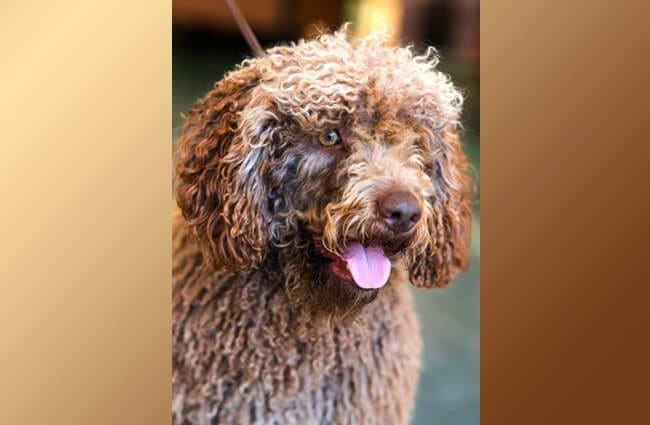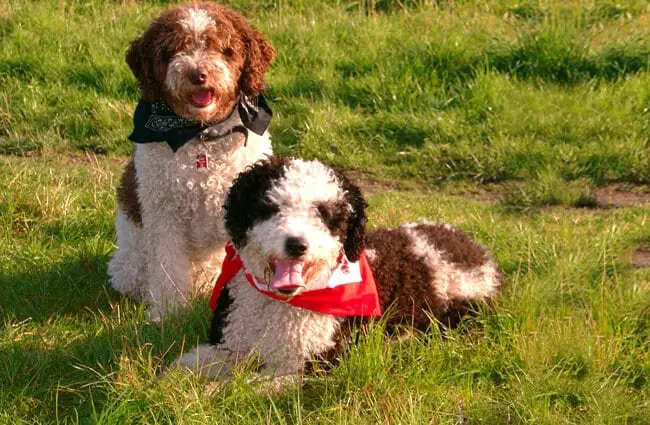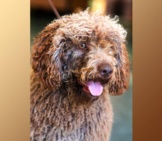The Spanish Water Dog was developed in the Iberian Peninsula for herding and retrieving purposes. Along the coasts, the Spanish Water Dog (“SWD”) was used for retrieving nets, and guarding the day’s catch. The Spanish has webbed feet, making them excellent swimmers with a drive to retrieve. Inland, the SWD was used for herding purposes, and is often found herding sheep and even their humans at times.
This dog is known for its unique, dreadlocked coat, which is adaptable for dry to humid climates, from both inland and coastal Spain. The specific origin of the breed is often disputed between North Africa and other European countries.
One thing is for certain, the SWD is a driven working breed known for being mischievous, so if you’re ready for an all-around athletic breed with a lot of personality, this may be the right breed for you! Read on to learn more about the Spanish Water Dog.
Description of the Spanish Water Dog
The Spanish Water Dog is known for being extremely versatile, bred for both retrieving in the water and herding livestock. This well-rounded breed is extremely intelligent and driven, so if you’re looking to add an active breed into your lifestyle, the SWD can be a unique and lovable addition to your family.
This dog breed was built to be active, and has a strong desire to work hard. Given their intelligent and athletic nature, the SWD benefits from a variety of activities that stimulate both mentally and physically. Puzzle toys and regular training can keep your Water Dog mentally satisfied, while agility courses, dock diving, herding, sport competitions, and more will physically satisfy the breed.
The Spanish Water Dog is considered a medium-sized dog with a remarkably curly coat. If grown long enough, the coat will begin to wrap around itself, creating cords that are much like a dreadlock. This breed is robust with a deep chest, slightly longer than it is tall.
It can be various shades of black, brown, beige or white, or parti-color where the secondary color is always white. Tricolor, or parti-color where the second color is not white, is not considered to be within the breed standard.
Life Expectancy and Size
The Water Dog typically lives about 12-15 years. Proper breeding, nutrition, and exercise will allow your SWD to live a long and happy life.
The standard Spanish Water Dog stands at approximately 16-20 inches at the shoulder, and weighs between 30 and 50 pounds. Female Water Dogs are typically shorter, between 16 and 18 inches, while the males tend to stand between 17 and 20 inches. The female averages 31-40 pounds, and the male averages 40-49 pounds.
Protective Ability
This dog breed is naturally suspicious of strangers. They make for an excellent watchdog with highly protective instincts. When properly introduced to strangers, the Water Dog will accept strangers, but mainly only be affectionate with its own people.
That being said, this dog, when not properly socialized with strangers and dogs as a puppy, can be fearful or even aggressive towards these groups. When properly socialized, the SWD will still make for an excellent watch dog, and securely maintain its territory.
Training
The Spanish Water Dog is stubborn and highly intelligent. This breed can be overwhelming for a new dog owner, so the SWD is best suited for an owner with dog training experience. Early and extensive socialization is vital for providing good foundations for future encounters.
With a knowledgeable owner and continual training, the SWD can be a diligent worker, and incredible addition to the family. He is eager to please, so use positive reward systems in training. Correction-based training is not advisable in this breed, as they thrive in their willingness to work for you.
The Water Dog does have a prey drive, so training for reliable recall is crucial. Even with the best trained dog, once chasing a deer, they can forget all the training and recall they have. It is vital to have reliable fencing, and genuinely know your own dog’s obedience level.
Energy Level
The Spanish Water Dog is a natural born worker. This being said, the SWD, when properly exercised, can be a gentle and affectionate indoor dog. This includes both physical and mental stimulation, as they are an extremely intelligent breed. Without proper exercise, this dog can become destructive.
Originally bred for herding and retrieving in water, the Water Dog is not best for a first-time dog owner. An owner with dog experience and an active lifestyle, hiking, swimming, and running, who is equally diligent about the dog’s intellectual stimulation, will make for a great match.
What Living with a Spanish Water Dog is Like
The Spanish Water Dog is a unique breed in that not a lot of families have them. It is important to know that this dog is known for being naturally suspicious of strangers, making proper socialization a must. A naturally suspicious dog that lacks proper socialization can become fearful, or worse, aggressive.
With proper socialization, the SWD will remain naturally suspicious, and alert you to strangers near or around the residence. This breed, once introduced to strangers, will accept them into the residence, but will rarely if ever show affection or attention.
The SWD is mainly affectionate towards their own family, and has been described as a bit of a “control freak.” With a herding background, this dog will try to control bikes, children, family members, and even cars, to make sure they always know where you’re going and what you’re doing.
This breed has a lot of personality and spunk. If you’re an experienced dog owner, who is ready for the challenge, the Spanish Water Dog can be a rewarding and caring addition to the family.
Care of the Spanish Water Dog
The Water Dog was bred to be extremely adaptable for multiple climates within the Iberian Peninsula. It can thrive in dry and humid climates, with a coat that protects it from the elements.
While grooming is non-existent in this low-shedding breed, the SWD does require trimming at least two times a year, to your preferred coat length. Be advised that the Spanish Water Dog’s coat, when long enough, will form cords. Special attention and care will be needed to maintain the cords properly and prevent hot spots and/or matting.
The biggest on-going care required of the SWD is continual obedience training for mental and physical stimulation.
Environmental Needs
The Water Dog is suitable for a variety of climates, and is extremely adaptable. If you hope to keep the Spanish Water Dog outside, always provide water and a dog house for protection from the elements, and a safe place from which to guard the house.
Exercise Needs
As a herding and retrieving dog with a high prey drive, this breed requires consistent, daily exercise and stimulation. The SWD thrives in agility courses, dock diving, and various dog sport competitions. This breed needs a purpose or job that gives him either mental or physical stimulation, ideally both.
When given proper mental and physical stimulation, the Water Dog can transition into the home and remain calm. Any dog can become excessive in barking, digging, and even destructive, so it’s imperative that your SWD is given good outlets for his energy, and mental stimulation every day.
Shedding and Grooming
The Spanish Water Dog is a low-shedding breed that requires trimming twice every year. Length of coat is determined by the owner’s preference; however, it is important to know that the hair will begin to form cords.
These cords require special maintenance, so it is important to understand the needs of the cords/coat before attempting it. These cords can easily bond to one another creating mats and hot spots, which can be extremely painful if not cared for properly.
The coat is not meant to be brushed, so mainly, upkeep applies to twice (or more) yearly trims and keeping the cords maintained. The dog’s nails should be trimmed regularly, and teeth brushing should occur three times a week.
Ideal Home Environment
The ideal home for a Spanish Water Dog is prepared for an active, working dog lifestyle. Climate is not much of a factor for the SWD, as they are highly adaptable and built for a variety of conditions.
Health Concerns
This breed is generally fairly healthy when bred properly. Responsible Spanish Water Dog breeders will screen their dogs for hip dysplasia and eye anomalies that are common in the breed. The Water Dog can also be affected by allergies, glaucoma (eye disease), and hypothyroidism (hormone imbalance).
Mainly, the biggest factors to consider are the ones that are in your control as an owner. Find a reputable breeder who can tell you about the parents and grandparents of the litter. Meet all members of the bloodline if you can, and ask for papers and do your research on the breed as well as the breeders.
Lastly, the main factor you can control for your puppy is his weight. Obesity can be an extremely detrimental health factor for your pup, and it is entirely in your control. If your dog is beginning to gain weight beyond healthy standards, consult a vet for a weight management and exercise regimen.
Behavior Problems
The Spanish Water Dog is a naturally cautious dog that has a high prey drive. Early socialization is key to prevent issues in maturity. While your Water Dog will always be cautious around strangers, and maintain their role as a watch dog, proper socialization can prevent fear or even aggression towards visitors.
























![Red Angus Closeup of a beautiful Red Angus cowPhoto by: U.S. Department of Agriculture [pubic domain]https://creativecommons.org/licenses/by/2.0/](https://animals.net/wp-content/uploads/2020/03/Red-Angus-4-100x75.jpg)

